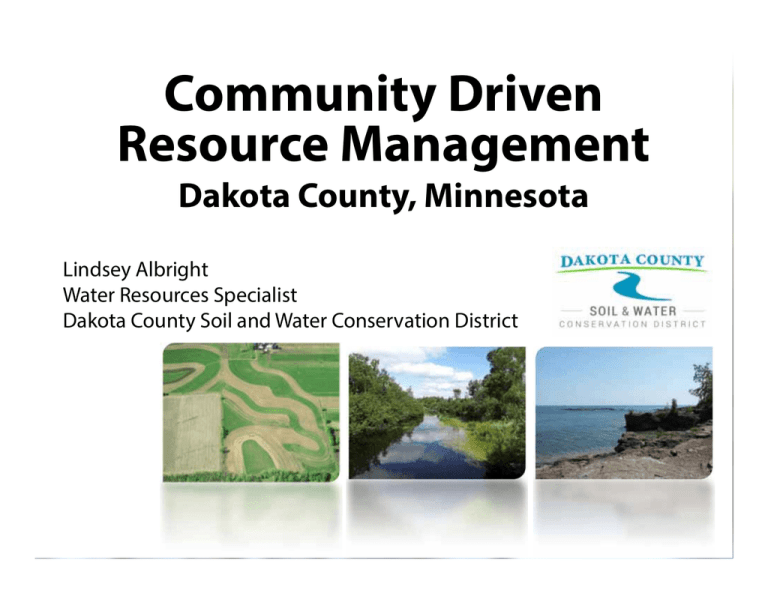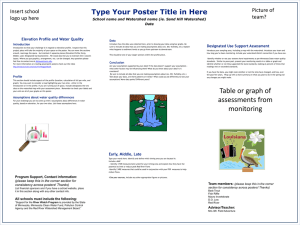Community Driven Resource Management Dakota County, Minnesota Lindsey Albright
advertisement

Community Driven Resource Management Dakota County, Minnesota Lindsey Albright Water Resources Specialist Dakota County Soil and Water Conservation District Dakota County Soil and Water • Organized by local farmers and certified by the Secretary of State on February 11, 1944 • Formed in the early to mid 1940's in response to national concern over floods, erosion, and the dust storms of the 1930’s – Primary goal: work with local farmers to establish practices to conserve soil and increase production on their land. Today, work with partners to conserve and manage land and water resources Partner Organizations • • • • • • • • • Minnesota Pollution Control Agency Minnesota Department of Natural Resources Board of Soil and Water Resources USDA Natural Resources Conservation Service Watershed Management Organizations University of Minnesota – Extension Metropolitan Council Cities and Townships Dakota County Watersheds • Black Dog WMO • Eagan-Inver Grove WMO • Lower Minnesota River Watershed District • Lower Mississippi WMO • North Cannon River WMO • Vermillion River Watershed Joint Powers Organization Dakota County Stats • 398,552 population (2010) • 587 square miles • 2/3 Urban and 1/3 Rural SWCD Conservation Practices SWCD Program Goals • Protect and Restore Surface Water Quality • Improve Soil Health and Groundwater Quality • Improve Public Awareness of Water Resource Goals • Conduct Water Monitoring and Land Assessments • Protect and Restore Habitats • Reduce Flood Impacts Community Programming Agricultural Water Resources • Dakota County Crops Day • Minnesota Agricultural Water Quality Certification Program (MAWQCP) • Irrigation Incentive Program • Citizen Assisted Monitoring Program (CAMP) • Vermillion River Watch Stream Monitoring • Aquatic Invasive Species Education • Outdoor Education Days • Landscaping for Clean Waters Workshops Partner Organizations: USDA Natural Resources Conservation Service University of Minnesota – Extension Dakota County Dakota Electric Association Crops Day Presentations • Introduce the latest crop management strategies – Nitrogen Fertilizer Management Plan – Irrigation management tools and technology – Soil moisture monitoring technology – University of Minnesota Extension Nitrogen Smart program – Minnesota Agriculture Water Quality Certification program – Groundwater nitrate studies Partner Organizations: Minnesota Department of Agriculture Minnesota Board of Soil and Water Resources Minnesota DNR Minnesota Pollution Control Agency USDA Natural Resources Conservation Service County governments Watershed Management Organizations MAWQCP Voluntary opportunity for farmers and agricultural landowners to take the lead in implementing practices to promote and protect water quality Benefits to Producers Regulatory certainty: in compliance with any new water quality rules or laws during the period of certification Recognition: ability to promote their business as protective of water quality Benefits to Producers Priority for technical and financial assistance: obtain specially designated technical and financial assistance to implement conservation practices that promote water quality MAWQCP Application Self-verification by producers that practices meet existing laws and regulations regarding water quality Laws that are considered include shoreland setbacks, feedlot permits, disposal of waste pesticides MAWQCP Assessment • Evaluation of each field within the operation using an online assessment tool • Assessment tool considers: – Physical field characteristics – Nutrient management factors – Tillage management factors – Pest management – Irrigation and tile drainage management – Conservation practices MAWQCP Verification • Score of 8.5 or higher (max of 10) is necessary for certification eligibility • On‐farm field verification with licensed certifier – DCSWCD staff • Recognition as Minnesota Water Quality Certified Farm Partner Organizations: Vermillion River Watershed Joint Powers Organization (VRWJPO) University of Minnesota Extension Dakota County Program Specifics • Voluntary participation on 30 fields, averaging approx. 100 to 150 acres • Provide services to collect field-specific moisture and direct assistance to producers using the “Irrigation Scheduling Checkbook” Incentives • Total annual cost is $600/field • Program provides $400/field • Producer is responsible for the remaining $200/field • University of Minnesota Extension staff will provide information about field-measured soil moisture conditions and consultation on scheduling their next irrigation cycle. Future Irrigation Planning Assist agricultural producers in being: • proactive in advance of potential regulations • demonstrating measures to improve surface and groundwater quality and quantity • potentially avoiding regulatory burdens Partner Organizations: Metropolitan Council County, City, and Township governments Watershed Management Organizations CAMP Program • Citizen lake monitoring • Local Watershed Management Organizations and Cities sponsor monitoring activities • Lab analysis and volunteer coordination facilitated by the Metropolitan Council CAMP Monitoring Activities • Bi‐weekly monitoring April through October • Field measurements include: – Water temperature – Transparency using a Secchi disc – physical and recreational condition (user perception) • Surface water sample for lab analysis of: – Total phosphorus – Total Kjeldahl Nitrogen – Chlorophyll‐a. Water Quality Data Uses • Document water quality status and trends • Provide lake and watershed managers and city staff with water quality data • Data submitted to MPCA to be used in impairment listings and Watershed Restoration and Protection Strategy (WRAPS) projects Partner Organizations: Vermillion River Watershed Joint Powers Organization Minnesota Pollution Control Agency Vermillion River Watch • Partnership with Hastings and Rosemont High School Districts • Stream monitoring activities using the Volunteer Stream Monitoring protocol • Macroinvertebrate IDs • Canoe trip on Mississippi Citizen Stream Monitoring • Monitoring transparency with Secchi tube – Data submitted to MPCA for water quality assessment and impairment determination • Engage WMOs, nature centers, school districts, and Dakota County Parks programs • Data useful to North Cannon River Watershed Management Organization Partner Organizations: Dakota County Minnesota DNR Watershed Management Organizations Local AIS Prevention Aid • Funding from Minnesota state legislature • Provided to Minnesota counties to support AIS prevention programs: – Early Detection Monitoring – Boat Launch Inspectors – Public Outreach and Community Education Dakota County Activities Monitoring Outreach • Summer 2016: AIS • Update AIS signage at vegetation monitoring boat launch on 20 lakes with County • Advertisements posted access at gas stations near to county boat launches • Future activities: – – – – Lakes with city launches Private access lakes Vermillion River North Cannon Watershed Potential AIS Programming • Volunteer AIS monitoring program – Expansion of Citizen Stream Monitoring Program or part of the Wetland Health Evaluation Program • • • • • AIS Early Detector Monitoring Training County parks AIS summer camp programming Educational kiosks and/or signage at launches Offer AIS art competition at high schools Portable boat washing station Partner Organizations: Vermillion River Watershed Joint Powers Organization USDA Natural Resources Conservation Service University of Minnesota - Extension Minnesota DNR Pheasants Forever Dakota County Parks and Nature Centers Outdoor Education Days • Host over 1,000 5th grade students from local elementary schools • 220-acre native prairie site on DC Fairgrounds • Station topics include: – Water Quality – Forestry – Soils – Wetlands – Agriculture Partner Organizations: Watershed Management Organizations Local Cities and Townships How the program works What is a Raingarden? • Shallow depression with flat bottom • Dry in less than 24 hours • Contains plants with deep roots, ideally other pollinator and wildlife benefits • Soil microbes filters out pollutants • Designed as a landscape feature Raingarden Animation Just like a regular planting, but able to absorb rainwater and breakdown pollutants Concept ‐ Gregg Thompson, Illustration ‐ Taina Litwak, Animation ‐ Ron Struss A raingarden at work ``` Photo and Animation: Joe Barten and Ron Struss Curt Coudron, Dakota SWCD Raingardens for Entire Neighborhoods Rushmore Drive Burnsville Two identical neighborhoods: 17 raingardens installed in one of them Raingardens for Entire Neighborhoods Burnsville – Rushmore Drive 5.3 acres ‐ 25 Homes ‐ 17 Raingardens Designed by: Barr Engineering Raingardens for Entire Neighborhoods Very similar pattern during rainfall Monitoring Results Before Raingardens Raingardens for Entire Neighborhoods No raingardens Monitoring Results After 85% Reduction in Volume With raingardens Where did the water go? BEFORE City of Burnsville Designed by: Barr Engineering AFTER City of Burnsville Designed by: Barr Engineering Design Courses Courses All Around Dakota County • Work with professionals to design a plan specific for your yard • Receive a copy of The Blue Thumb Guide to Raingardens • Learn about cost share opportunities to help offset the cost of your raingarden • Access to $250 grants and technical assistance • All for $25 fee! 600 square feet of roof drainage Raingarden 200 square foot Raingarden Aerial View of House Cost Estimate Worksheet Total: 614.50 Raingarden Design and Planting Plan SWCD Community Programs • Balance of rural and agricultural interests • Look for innovative ways to engage the public in resource management • Promote programming that is useful to the community • Funding is great, but technical assistance is also appreciated Lindsey Albright Water Resources Specialist lindsey.albright@co.dakota.mn.us QUESTIONS??




